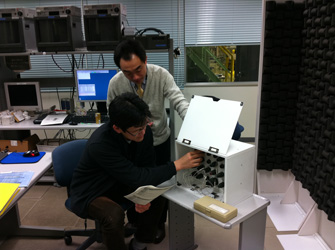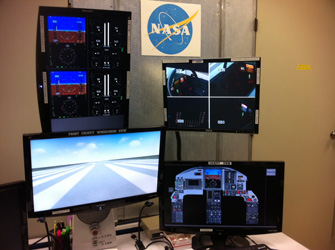Hello, everyone. With Japan buried in heavy snow and flu, how have you been these days?
I was almost frozen with cold when I returned to Japan with Astronaut Onishi for about a fortnight in January for operational training on the Japanese Experiment Module (JEM), known as "Kibo", at the Tsukuba Space Center (TKSC) in Ibaragi pref.
Despite some cold days, Houston, which I currently call home, is a normally temperate region on the Gulf of Mexico. Since moving here in 2009, I seem to have got fully accustomed, both physically and mentally, to the Houston lifestyle.
It was my second training for "Kibo" after the initial round last summer. Following the "Kibo" user qualifications and then those of the next-level operator acquired in the initial training, I returned aiming to go one level higher to the Kibo specialist qualification.
Formerly, during the Space Shuttle era, astronauts were categorized into classes including Captain, Pilot, Mission Specialist (MS), and Payload Specialist (PS). The captain and pilot had to take charge of maneuvers and safe flight of the Space Shuttle, MS professionally manipulated the robotic arm and extravehicular activities (EVA) and PS were in charge of scientific experiments in space.
Today, during this Space Station era, astronauts other than the Commander, who commands the whole team while taking charge of its safety, are all called "flight engineers". Not only is each member capable of manipulating the robotic arm and working in a spacesuit outside the module, each also conducts scientific experiments by communicating with chief scientists on the ground while studying about varied space experiments implemented on board the Space Station.
My explanation seemingly reveals an image of contemporary astronauts as super-professional, combining both Mission Specialist and Payload Specialist skills during the Space Shuttle era, right? Even with training time maximized, it is bound to be difficult for astronauts to fully understand the complex system of the Space Station and study all the scientific experiments scheduled to be conducted on board. Astronauts there share duties according to their specialized assigned fields.
The work on board is assigned like this: Astronaut A specializes in, and takes charge of, the environmental control and power supply systems. Astronaut B is in charge of the heat exhaust, communication, and control computer systems, while Astronaut C takes charge of the Japanese Experiment and European Experiment Modules. Astronauts share experiments scheduled to be implemented on board during their long-duration stay: Astronaut A conducts an experiment while Astronauts B and C collectively conduct another experiment. They prepare for their actual mission with training and preparation according to plan. Regardless of whether missions or space activities, teamwork is always required. This is due to the fact that each crew member on board assumes responsibility for specialized work respectively assigned.
Additionally, the qualifications of User, Operator, and Specialist, which I acquired, precisely define the specialty of astronauts demanded in the current Space Station era.
In terms of the segment provided by Russia in the Space Station referred to as the Russian segment, for example, I was qualified as User after training in Russia last year. Though allowed to live in that segment, I am not allowed to operate the equipment installed inside.
Conversely, in terms of the U.S. segment provided by the U.S., I have Operator qualification acquired after the two-year Basic Training program in Houston, which means I have knowledge and skills for manipulating varied systems (categorized into several, including those for environment control, heat exhaust, posture control, and the computer system controlling the Space Station) "in a steady state with no trouble and disorder" installed in the U.S. segment.
Even when supported by Operator, a long-duration mission also demands skills to modify and repair equipment, in the event of any trouble in space. It is the Specialist who has had training to cope with such unexpected troubles.
As I described above, it takes a very long time for a single astronaut to familiarize him/herself with all systems onboard the Space Station. Each specialist is trained by his/her team members who share and take charge of their assigned specialized fields
Astronaut Yui, selected as a member of the long-duration mission last year, must currently undergo Specialist-level training for several systems, boosting his Operator-level skills and knowledge for all systems in the U.S. segment acquired through the Astronaut Candidate (ASCAN) training.
After being selected as a mission crew member, astronauts have 30 months of training before their spaceflight actually starts. It may look leisurely to many of you, but the reality is quite different. The selected astronauts have hectic days, with training and study scheduled down to the minute for thorough preparation: attaining the required knowledge and skills for their assigned specialized fields, studying about scientific experiments scheduled during their mission, learning how to manipulate the Russian Soyuz Spacecraft used for their round-trip spaceflight to the Space Station...
Besides, Japanese astronauts also have their own prerequisite specialty, the Japanese Experiment Module "Kibo" Specialist. Astronauts from the U.S., Europe, and Canada support us and work as Kibo Specialists on board the Space Station while Japanese astronauts are away. Hence Japanese astronauts, despite being equivalent Specialists, should desirably be "Kibo Super Specialist", with far more detailed knowledge.
In case any defect or trouble should occur, the Specialist expounds to the Commander the influences on the whole mission, sometimes communicating with the control center on the ground in his/her place. On the Japanese Experiment Module "Kibo", the most intricate system on the Space Station with an Exposed Facility (EF), its unique robotic arm, and Airlock, it is critical that Japanese crew members who fully understand the national module should remain in charge of its operation.
Here finally I reach the topic described in the opening lines of this month's column, "I returned to Japan for training!" My explanation of how astronauts' work is categorized went beyond the given space again.
As previously described, none of us new astronauts can hold our heads before the astute instructors at the Tsukuba Space Center, always smiling and gentle, who ingeniously educate us, sometimes letting us go as we please, sometimes cracking the whip.
When I told experienced American pilots with whom I work in Houston before returning to Japan that I would go to Japan in January, many of them asked me to give their best regards to the instructors at the Tsukuba Space Center because they were really indebted to them during their mission training. It makes me think that even veteran pilots feel so obliged to the instructors that they cannot hold their heads before them after the training.
As well as space development, many other training opportunities are being tested and encountering various difficulties due to their austere budgets. I do hope to introduce part of the creativity, device, passion, and contribution of our Japanese training instructors, which more than makes up the plight. Maybe next time. Now let me introduce to you ...not an advance announcement of next month but some scenes from our training. They are professional instructors, Messrs. Kano and Amanai, explaining the operation procedures to use with their hand-made (!) models.

Mr. Amanai, Training Instructor at the Tsukuba Space Center

Mr. Kano, Training Instructor at the Tsukuba Space Center
* Credit: JAXA












Flight training is very effective for building astronauts' fundamental ability because it includes complicated operations while various matters are communicated with the ground.
Training with the plane went very well as I used the same type of plane when I was in Houston.
The plane I operated employed the newest design around the cockpit compared to those I used to board at the time.
I felt that, just as human space development enters the next spaceship stage following the retirement of the space shuttles, the aircraft industry is also shifting to the next era.
I will retain my skill as an astronaut as well as absorbing technological changes, as seen in this aircraft, toward the development of a Japanese original spacecraft.